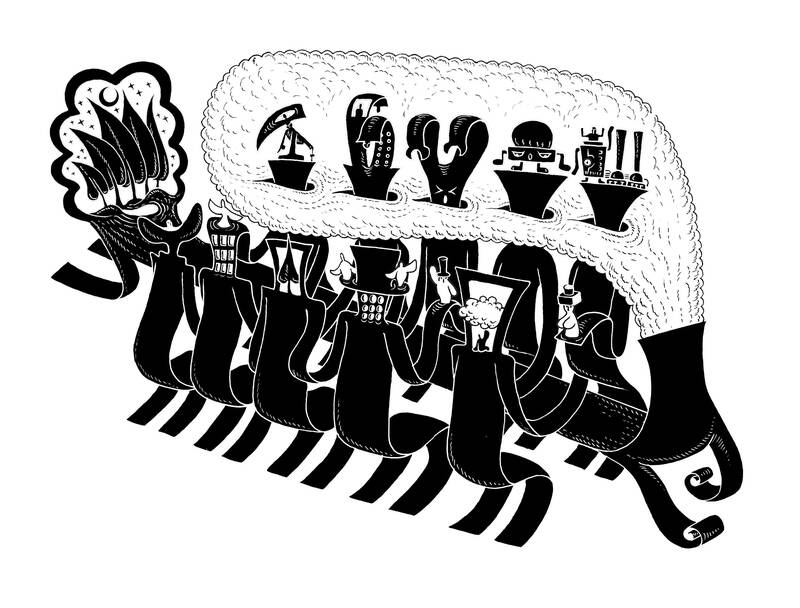Aonther climate conference, another failed climate conference.
That is the sense you might get from the anguished statements emerging at the close of the COP30 meeting in the Brazilian city of Belem at the weekend. Hopes that the final communique would incorporate a roadmap to transition away from fossil fuels were dashed. A planned US$125 billion fund for forest protection ended up with just US$6 billion or so committed.
However, that assessment confuses where we are going wrong on climate — and what we are getting right.

Illustration: Mountain People
Take the weird refusal to mention fossil fuels in the agreement. That is not quite the disaster it appears to be. Given the ability of oil exporters to veto every word of the text, it is quite remarkable that such references ever made it through the drafting process. The fact that petroleum producers are now balking more aggressively at naming the problem we all face is a sign not of the failure of the energy transition, but of its success.
The International Energy Agency’s central expectation for fossil fuel consumption in 2050 has been cut by 12 percent since the F-words were first officially mentioned at COP26 in Glasgow, Scotland, four years ago. Consumption of coal in the two biggest users, China and India, has fallen this year. These are far more substantive outcomes than the terminology of a UN document.
That is not to tell a triumphal story about the progress of climate policy this year — only to say that the real problems are far away from the conference halls in Belem.
If you want to understand what we are really doing wrong, look instead at an obscure page on a UN Web site where governments lodge their emissions-reduction plans, known as Nationally Determined Contributions (NDCs). Better still, go to Climate Action Tracker, a project that tries to translate these jargonistic documents into something approximating plain English.
The NDCs are arguably the most important element of the Paris Agreement — the 2015 deal in which every country, for the first time, agreed to limit their greenhouse pollution. They are meant to set clear, verifiable targets that can be measured against the best available science and get progressively more ambitious. As we have written, there is good evidence that governments that actually commit to such goals achieve them.
The latest list of plans, laying out where emissions will be in 2035, were intended to be a centerpiece of COP30. They fall far short of what is needed. Of the 10 biggest polluters accounting for three-quarters of carbon emissions, just two — the EU and Japan — have submitted documents with any hope of being enacted. The administration of former US president Joe Biden put in a US plan six weeks after US President Donald Trump was elected, rendering the entire effort futile on delivery. India, Iran, Saudi Arabia and South Korea still have not come up with their proposals. China, Russia and Indonesia have presented roadmaps so timid that they would be able to increase their emissions substantially from current levels and still claim they hit the mark.
The lackluster effort is in keeping with the tenor of politics today. Whether they are promising sanctions in retaliation for TV advertisements, threatening to behead a foreign leader, invading their neighbors or bombing apartment blocks into rubble, the authoritarians in charge of the major powers do not like to sign on to anything these days that constrains them.
It is citizens who will ultimately decide the path of the future, though — and there, the picture is far brighter.
At times, they are taking the energy transition into their own hands — whether it is Pakistani households quitting a fossil-fired grid to use cheaper solar instead, or Turkish drivers switching to electric vehicles faster than Americans or Australians.
At other times, they are the ones responsible for implementing policies, delivering far more positive outcomes than their leaders would have you believe. For all you might have read about phalanxes of gas turbines and coal plants being lined up to power the US’ data-center explosion, some 10 months into the Trump administration, just 11 percent of the generating capacity under construction is based on fossil fuels.
At still other times, they are finding themselves in the path of the devastating effects of climate change itself.
Most of the technology we will need to solve this problem is already in our hands and cheaper than the alternative, if only we would remove the morass of barriers and regulation we have erected to slow its advance. Our problem is that the world’s leaders are some of the last to see that.
Plenty of people of all generations are aware of the benefits of action to halt climate change, but with an average age of 69, the headstrong leaders of the 10 big emitters have rarely had less of a stake in the state of things when the current crop of NDCs matures in 2035. Almost half of the world’s population is younger than 30. It is up to the rest of us to guide the world to a better course.
David Fickling is a Bloomberg Opinion columnist covering climate change and energy. Previously, he worked for Bloomberg News, the Wall Street Journal and the Financial Times. This column reflects the personal views of the author and does not necessarily reflect the opinion of the editorial board or Bloomberg LP and its owners.

There has been much catastrophizing in Taiwan recently about America becoming more unreliable as a bulwark against Chinese pressure. Some of this has been sparked by debates in Washington about whether the United States should defend Taiwan in event of conflict. There also were understandable anxieties about whether President Trump would sacrifice Taiwan’s interests for a trade deal when he sat down with President Xi (習近平) in late October. On top of that, Taiwan’s opposition political leaders have sought to score political points by attacking the Lai (賴清德) administration for mishandling relations with the United States. Part of this budding anxiety
The diplomatic dispute between China and Japan over Japanese Prime Minister Sanae Takaichi’s comments in the Japanese Diet continues to escalate. In a letter to UN Secretary-General Antonio Guterres, China’s UN Ambassador Fu Cong (傅聰) wrote that, “if Japan dares to attempt an armed intervention in the cross-Strait situation, it would be an act of aggression.” There was no indication that Fu was aware of the irony implicit in the complaint. Until this point, Beijing had limited its remonstrations to diplomatic summonses and weaponization of economic levers, such as banning Japanese seafood imports, discouraging Chinese from traveling to Japan or issuing
On Nov. 8, newly elected Chinese Nationalist Party (KMT) Chairwoman Cheng Li-wun (鄭麗文) and Vice Chairman Chi Lin-len (季麟連) attended a memorial for White Terror era victims, during which convicted Chinese Communist Party (CCP) spies such as Wu Shi (吳石) were also honored. Cheng’s participation in the ceremony, which she said was part of her efforts to promote cross-strait reconciliation, has trapped herself and her party into the KMT’s dark past, and risks putting the party back on its old disastrous road. Wu, a lieutenant general who was the Ministry of National Defense’s deputy chief of the general staff, was recruited
The Food and Drug Administration (FDA) on Nov. 5 recalled more than 150,000 eggs found to contain three times the legal limit of the pesticide metabolite fipronil-sulfone. Nearly half of the 1,169 affected egg cartons, which had been distributed across 10 districts, had already been sold. Using the new traceability system, officials quickly urged the public to avoid consuming eggs with the traceability code “I47045,” while the remainder were successfully recalled. Changhua County’s Wenya Farm — the source of the tainted eggs — was fined NT$120,000, and the Ministry of Agriculture instructed the county’s Animal Disease Control Center to require that